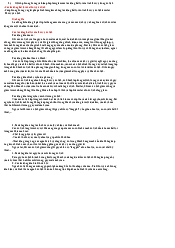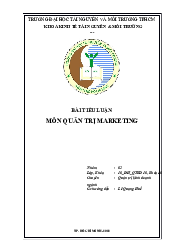




















Preview text:
Chap 5
2. Identify and describe the business model
element that specifies how the company's
product will fulfill the needs of its customers.
A.2.2 The value proposition element of the business
model describes how the company's product will fulfill
customer needs. It describes why customers would
want to do business with your company rather than
another Typical e-commerce value propositions include
personalization, customization, convenience, and
reduction of product search and price delivery costs.
.3. How can e-commerce technologies be used to
improve a firm's value web?
Firms can use Internet technologies to improve
communication and coordination with suppliers and
logistics partners, with customers and partners.
Collaboration technologies can be used with partners
and suppliers to create new products
5 What is a disruptive technology, and how does
it differ from a sustaining technology?
A disruptive technology is one that is at the core of a
change in the way business is done. In contrast, a
sustaining technology is a utechnology that enables
the incremental improvement of products and services,
helping a company cope with competitive pressures
and serve its customers with less expensive, more powerful, or unique products.
7.What is an on-demand services company?
. an on-demand services company is a company that
offers content or services charges a subscription fee for
access to some or all of its offerings monthly.
9. What are the benefits offered by incubator
investor firms over other traditional sources of capital?
Incubators provide a variety of services to
participating startups, such as business, technical, and
marketing assistance, and introductions to sources of
financing In addition, unlike venture capital and angel
investors, they do not become owners or partial owners of the company
10. What is an unfair competitive advantage?
An unfair competitive advantage occurs when one firm
develops an advantage based on a factor that other
firms cannot purchase (Barney, 1991)
11. What is an industry structural analysis and
what is its place in the ecommerce business plan?
An industry structural analysis is an effort
to understand and describe the nature of competition in
an industry, the nature of substitute products, the
barriers to entry, and the relative strength of
consumers and suppliers. Its goal is to identify the
impact that e-commerce has made on the overall
business environment and as well as areas of
profitability of doing business within that industry
13 What Has been the effect of e-
commercetechnologies on general interfirm rivalry?
A.2.12. Inter-firm rivairy (competition) is one area of
the business environment where e-commerce
technologies have had an impact on most industries. In
general, e-commerce has increased price competition
in nearly all markets. It has been relatively easy for
existing firms to adopt e-commerce technology and
attempt to use it to achieve competitive advantage.
Because consumers have access to global price
information, e-commerce produces pressures on firms
to compete by lowering prices (and lowering profits).
On the other hand, e-commerce has made it possible
for some firms to differentiate their product or services
from others. Therefore, although e-commerce has
increased emphasis on price competition, it has also
enabled businesses to create new strategies for
differentiation and branding so that they can retain higher prices.
.14. What disadvantages are faced by ""first-
mover" companies entering a marketspace?
A.2.14 The disadvantages faced by first-movers include
the potential lack of a variety of complementary
resources, such an existing and proven marketing and
management team, an established brand name and
reputation, and financial assets.
16. Describe the feature of information density
as it applies to e-commerce technology and
describe how it has affected the business
environment over the past decade.
Information density describes the total amount of
information available. In ecommerce technology,
information density pertains to information about
products, prices, customers, suppliers, etc. The
increase in information density means that consumers
and purchasers can more easily find and compare
products and prices, and has resulted in a shift of
power to consumers, who now have more information.
It also has reduced a business's costs in finding and
sharing information with suppliers and customers, and
hasresulted in lower industry and firm operations costs.
17. What kinds of firms are considered to be e- commerce enablers?
. They provide the hardware, operating system
software, networks and communications technology,
applications software, Web design, consulting services,
and other tools required for e-commerce.
19. Define market opportunity and describe how
you would determine a new company's realistic market opportunity?
19 Market opportunity is the overall potential revenues
within a given marketspace. To determine your realistic
market opportunity, you determine which niches of
that marketspace you will be able to compete in, and
determine the revenue potentials just within those niches.
.20. What are the main elements of an elevator pitch?
20. The main elements of an elevator pitch include
Incubators Angel investors, Venture capital investors and Crowdfunding. CHAPTER 1
# Define e-commerce, understand how e-commerce
differs from e-business, identify the primary
technological building blocks underlying e-commerce,
and recognize major current themes in e-commerce.
E-commerce involves digitally enabled commercial
transactions between and among organizations and
individuals. E-business refers primarily to the digital
enabling of transactions and processes within a firm,
involving infor- mation systems under the control of the
firm. For the most part, unlike e-commerce, e-business
does not involve transactions across organizational
boundaries where value is exchanged. The technology
juggernauts behind e-commerce are the Internet, the
Web, and increasingly, the mobile plat-form. From a
business perspective, one of the most important trends
to note is that all forms of e-commerce con- tinue to
show very strong growth. From a technology
perspective, the mobile platform has finally arrived
with a bang, driving astronomical growth in mobile
advertising and making true mobile e-commerce a
reality. At a societal level, major issues include privacy
and government surveillance, protection of intellectual
property, online security, and governance of the Internet.
# Identify and describe the unique features of e-
commerce technology and discuss their business significance.
There are eight features of e-commerce technology
that are unique to this medium:
4 Ubiquity-available just about everywhere, at all
times, making it possible to shop from your desktop, at
home, at work, or even from your car.
Global reach-permits commercial transactions to cross
cultural and national boundaries far more conve-
niently and cost-effectively than is true in traditional commerce.
Universal standards--shared by all nations around the
world, in contrast to most traditional commerce tech-
nologies, which differ from one nation to the next.
Richness-enables an online merchant to deliver
marketing messages in a way not possible with
traditional commerce technologies.
Interactivity-allows for two-way communication
between merchant and consumer and enables the
merchant to engage a consumer in ways similar to a
face-to-face experience, but on a much more massive, global scale.
Information density-is the total amount and quality of
information available to all market participants. The
Internet reduces information collection, storage,
processing, and communication costs while increasing
the currency, accuracy, and timeliness of information.
Personalization and customization-the increase in
information density allows merchants to target their
mar- keting messages to specific individuals and results
in a level of personalization and customization unthink
able with previously existing commerce technologies.
Social technology-provides a many-to-many model of
mass communications. Millions of users are able to
generate content consumed by millions of other users.
The result is the formation of social networks on a wide
scale and the aggregation of large audiences on social network platforms.
# Describe the major types of e-commerce.
There are six major types of e-commerce:
B2C e-commerce involves businesses selling to
consumers and is the type of e-commerce that most
consumers are likely to encounter.
B2B e-commerce involves businesses selling to other
businesses and is the largest form of e-commerce.
C2C e-commerce is a means for consumers to sell to
each other. In C2C e-commerce, the consumer
prepares the product for market, places the product for
auction or sale, and relies on the market maker to
provide catalog, search engine, and transaction
clearing capabilities so that products can be easily
displayed, discov-ered, and paid for.
Social e-commerce is e-commerce that is enabled by
social networks and online social relationships.
M-commerce involves the use of wireless digital
devices to enable online transactions.
Local e-commerce is a form of e-commerce that is
focused on engaging the consumer based on his or her cur rent geographic location.
# Understand the evolution of e-commerce from its early years to today.
E-commerce has gone through three stages:
innovation, consolidation, and reinvention . The early
years of e-commerce were a technological success,
with the digital infrastructure created during the period
solid enough to sustain significant growth in e-
commerce during the next decade, and a mixed busi-
ness success, with significant revenue growth and
customer usage, but low profit margins. E-commerce
entered a period of consolidation beginning in 2001 and extending into 2006.
E-commerce entered a period of reinvention in 2007
with the emergence of the mobile digital platform,
social networks, and Web 2.0 applications that
attracted huge audiences in a very short time span.
# Describe the major themes underlying the study of e-commerce.
E-commerce involves three broad interrelated themes:
Technology-To understand e-commerce, you need a
basic understanding of the information technologies
upon which it is built, including the Internet, the Web,
and mobile platform, and a host of complementary
technologies-cloud computing, desktop computers,
smartphones, tablet computers, local area networks, client/server computing, packet-switched
communications, protocols such as TCP/IP, web
servers, HTML, and relational and non-relational databases, among others.
Business-While technology provides the infrastructure,
it is the business applications-the potential for
extraordinary returns on investment-that create the
interest and excitement in e-commerce. Therefore, you
also need to understand some key business concepts
such as electronic markets, information goods,
business models, firm and industry value chains,
industry structure, and consumer behavior in digital
markets. Society-Understanding the pressures that
global e-commerce places on contemporary society is
critical to being successful in the e-commerce
marketplace. The primary societal issues are
intellectual property, individual privacy, and public policy.
Identify the major academic disciplines
contributing to e-commerce.
There are two primary approaches to e-commerce:
technical and behavioral. Each of these approaches is
repre sented by several academic disciplines.
On the technical side, this includes computer science,
operations management, and information systems On
the behavioral side, it includes information systems as
well as sociology, economics, finance and accou ing, management, and marketing.
CHAPTER 3Uderstand the questions you must ask
and answer, and the steps you should take, in
developing an e-commerce Questions you must ask
and answer when developing an e-commerce presence
include: What is your vision and how do you hope taccomplish it?
What is your business and revenue model?
Who and where is the target audience?
What are the characteristics of the marketplace?
Where is the content coming from? Conduct a SWOT analysis.
Develop an e-commerce presence map. Develop a timeline. Develop a detailed budget.
Explain the process that should be followed in
building an e-commerce presence.
Factors you must consider when building an e-
commerce site include hardware, software,
telecommunica bons capacity, website and mobile
platform design, human resources, and organizational
capabilities. The systems development life cycle (a
methodology for understanding the business objectives
of a system and designing an appropriate solution) for
building an e-commerce website involves five major steps:
Identify the specific business objectives for the site,
and then develop a list of system functionalities and
information requirements. Develop a system design
specification (both logical design and physical design).
Build the site, either by in-house personnel or by
outsourcing all or part of the responsibility to outside contractors.
Test the system (unit testing, system testing,
acceptance testing, A/B (split) testing, and multivariat testing).
Implement and maintain the site.
The basic business and system functionalities an e-
commerce site should contain include a digital catalog
a product database, customer tracking, shopping
cart/payment system, an on-site blog, a customer data
base, an ad server, a site tracking and reporting
system, and an inventory management system.
Advantages of building a site in-house include the
ability to change and adapt the site quickly as the
market demands and the ability to build a site that
does exactly what the company needs.
Disadvantages of building a site in-house include
higher costs, greater risks of failure, a more time-con-
suming process, and a longer staff learning curve that delays time to market.
Using design templates cuts development time, but
preset templates can also limit functionality. A similar
decision is also necessary regarding outsourcing the
hosting of the site versus keeping it in- house. Relying
on an outside vendor places the burden of reliability on
someone else in return for a monthly hosting fee. The
downside is that if the site requires fast upgrades due
to heavy traffic, the chosen hosting company may or
may not be capable of keeping up. Reliability versus
scalability is the issue in this instance. Identify and understand the major
considerations involved in choosing web server
and e-commerce merchant server software.
Early websites used single-tier system architecture and
consisted of a single-server computer that delivered
static web pages to users making requests through
their browsers. The extended functionality of today's
web-sites requires the development of a multi-tiered
systems architecture, which utilizes a variety of
specialized web servers, as well as links to pre-existing
backend or legacy corporate databases. All e-
commerce sites require basic web server software to
answer requests from customers for HTML and XML
pages. When choosing web server software, companies
are also choosing what operating system the site will
run on. Apache, which runs on the Unix system, is the market leader.
Web servers provide a host of services, including
processing user HTML requests, security services, file
trans- fer, a search engine, data capture, e-mail, and
site management tools. Dynamic server software
allows sites to deliver dynamic content, rather than
static, unchanging information. Web application server
programs enable a wide range of e-commerce
functionality, including creating a cus- tomer database,
creating an e-mail promotional program, and accepting
and processing orders, as well as many other services.
E-commerce merchant server software is another
important software package that provides catalog
displays. information storage and customer tracking,
order taking (shopping cart), and credit card purchase
process ing. E-commerce software platforms can save
time and money, but customization can significantly
drive up costs. Factors to consider when choosing an e-
commerce software platform include its functionality,
support for different business models, visual site
management tools and reporting systems,
performance and scalabil ity, connectivity to existing
business systems, compliance with standards, and
global and multicultural capa- bility.
Understand the issues involved in choosing the most
appropriate hardware for an e-commerce site. Speed,
capacity, and scalability are three of the most
important considerations when selecting an operating
system, and therefore the hardware that it runs on. To
evaluate how fast the site needs to be, companies
need to assess the number of simultaneous users the
site expects to see, the nature of their requests, the
type of information requested, and the bandwidth
available to the site. The answers to these questions
will provide guidance regarding the processors
necessary to meet customer demand, In some cases,
additional processing power can increase capacity,
thereby improving system speed.
Scalability is also an important issue. Increasing
processing supply by scaling up to meet demand can
be done through vertical or horizontal scaling or by
improving processing architecture.
Identify additional tools that can improve
website performance. In addition to providing a
speedy website, companies must also strive to have a
well-designed site that encour-ages visitors to buy.
Building in interactivity improves site effectiveness, as
do personalization techniques Commonly used
software tools for achieving high levels of website
interactivity and customer personalization include
Common Gateway Interface (CGI) scripts, Active Server
Pages (ASP) and ASP.NET, Java applets, Java- Script,
ActiveX and VBScript, Ajax, PHP, Ruby on Rails (ROR or Rails), and Django.
Understand the important considerations
involved in developing a mobile website and
building mobile applications.
When developing a mobile presence, it is important to
understand the difference between a mobile website
mobile web apps, native apps, and hybrid apps
. The first step is to identify business objectives,
because they help determine which type of mobile presence is best.
Design should take into account mobile platform
constraints. Recent trends include mobile first design,
responsive web design, and adaptive web design.
Developing a mobile website is likely to be the least
expensive option: mobile web apps require more effort
and cost; native apps are likely to be the most expensive to develop.
CHAPTER 5 E-commerce Business Strategies
Identify the key components of e-commerce business models.
A successful business model effectively addresses eight key elements:
Value proposition-how a company's product or service
fulfills the needs of customers. Typical e-commerce value propositions include personalization,
customization, convenience, and reduction of product
search and price delivery costs.
Revenue model-how the company plans to make
money from its operations. Major e-commerce
revenuemodels include the advertising model,
subscription model, transaction fee model, sales model, and affiliate model.
Market opportunity-the revenue potential within a
company's intended marketspace. Competitive
environment-the direct and indirect competitors doing
business in the same marketspace, including how
many there are and how profitable they are.
Competitive advantage-the factors that differentiate
the business from its competition, enabling it to
provide a superior product at a lower cost.
Market strategy-the plan a company develops that
outlines how it will enter a market and attract customers.
Organizational development-the process of defining all
the functions within a business and the skills necessary
to perform each job, as well as the process of recruiting and hiring strong employees.
Management team-the group of individuals retained to
guide the company's growth and expansion.
Describe the major B2C business models.
There are a number of different business models being
used in the B2C e-commerce arena. The major models include the following:
Portal-offers powerful search tools plus an integrated
package of content and services; typically utilizes a
combined subscription/advertising revenue/transaction
fee model, may be general or specialized (vortal).
E-tailer-online version of traditional retailer; includes
virtual merchants (online retail store only), bricks-and-
clicks e-tailers (online distribution channel for a
company that also has physical stores), catalog mer-
chants (online version of direct mail catalog), and
manufacturers selling directly to the consumer.
Content provider-information and entertainment
companies that provide digital content; typically
utilizesan advertising, subscription, or affiliate referral fee revenue model
Transaction broker-processes online sales transactions;
typically utilizes a transaction fee revenue model.
Market creator-uses Internet technology to create
markets that bring buyers and sellers together;
typically utilizes a transaction fee revenue model.
Service provider-offers services online.
Community provider-provides an online community of
like-minded individuals for networking and informa tion
sharing, revenue is generated by advertising, referral fees, and subscriptions
Describe the major B2B business models.
The major business models used to date in the B2B
arena include E-distributor-supplies products directly to individual businesses.
E-procurement-single firms create digital markets for
thousands of sellers and buyers. Exchange-
independently owned digital marketplace for direct
inputs, usually for a vertical industry group. Industry consortium-industry-owned vertical digital
market.Private industrial network-industry-owned
private industrial network that coordinates supply
chains with a limited set of partners.
■ Understand key business concepts and
strategies applicable to e-commerce.
E-commerce has had a major impact on the business
environment in the last decade, and has affected:
Industry structure-the nature of players in an industry
and their relative bargaining power by changing the
basis of competition among rivals, the barriers to entry,
the threat of new substitute products, the strength of
suppliers, and the bargaining power of buyers.
Industry value chains-the set of activities performed in
an industry by suppliers, manufacturers, transporters
distributors, and retailers that transforms raw inputs
into final products and services by reducing the cost of
information and other transaction costs.
Firm value chains-the set of activities performed within
an individual firm to create final products from raw
ipuuts by increasing operational efficiency. Business
strategy-a set of plans for achieving superior long-term
returns on the capital invested in a firm by offering
unique ways to differentiate products, obtain cost
advantages, compete globally, or compete in a narrow market or product segment.




